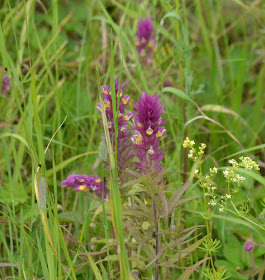Melampyrum arvense, commonly known as field cow-wheat, is an herbaceous flowering plant of the genus Melampyrum in the family Orobanchaceae.
Field cow-wheat is like other cow-wheats a hemiparasite - although it is a chlorophyll plant and can assimilate itself it also sucks nutrition from neighbouring plant-roots. It cannot flourish without a host from which to take nutrients.
In an experiment where the growth of M. arvense was compared on rye grass, alfalfa and flax, it was found to grow much the best on the leguminous plant, alfalfa.
 Field cow-wheat is quite rare in Denmark (only found in the Isles). It grows in dry and open land , in a dry habitat and chalky soil. Field cow-wheat has pink-purple flowers from June till August- September.
Field cow-wheat is quite rare in Denmark (only found in the Isles). It grows in dry and open land , in a dry habitat and chalky soil. Field cow-wheat has pink-purple flowers from June till August- September.The photos of field cow-wheat in this article are from the island Møn. (place Magleby)
It was earlier a problematic field weed, but apparently due to a change in farming methods it has disappeared from the fields. The best place to see the plant is probably in Seili, around the archipelago research centre. Field cow-wheat grows casually in different parts of southern Finland and on the shore of southern parts of the Gulf of Finland.
The upright stems of this species, which may branch, are terminated by a spike of pink to purple bracts amongst which the tubular flowers appear. Younger, lower bracts are green however, as the pink/purple colour appears and deepens only with time. The plant grows up to 40 or 60 cm high.
The ordinary leaves are lanceolate and opposite and may have short teeth. The bracts are also lanceolate and have long teeth up to 8 mm. The flowers are two-lipped with a closed throat and are 2 – 2.5 cm long. They are pink to purple with a yellow or white patch.
Field cow-wheat is distributed throughout Western Europe, southern Spain, southern Italy, Ireland, Iceland, Norway, central and northern Sweden, and northern Finland. Also its range extends east to the Ural Mountains, and it is found in Turkey. In Great Britain it only occurs in a few locations in south-east England.It is becoming rarer, at least in Britain, France, Belgium, Germany, the Netherlands and Finland; this may be due to a reduced area of arable land and changes in farming practices, such as seed-cleaning and intensification.
The flowers are pollinated by bumblebees. The seeds may be dispersed by ants which are attracted by a small oil body attached to each seed, and which carry them to their nests for food. Like some other species of Melampyrum on the undersides the bracts have minute nectar-producing glands, which attract ants, bumlebees and other insects. These glands are violet in the case of Melampyrum arvense, are visible under a hand lens and take the form of minute scales which secrete a sugary solution.
photo 2013 Magleby, Møn: grethe bachmann


No comments:
Post a Comment
Thank you for visiting my blog!